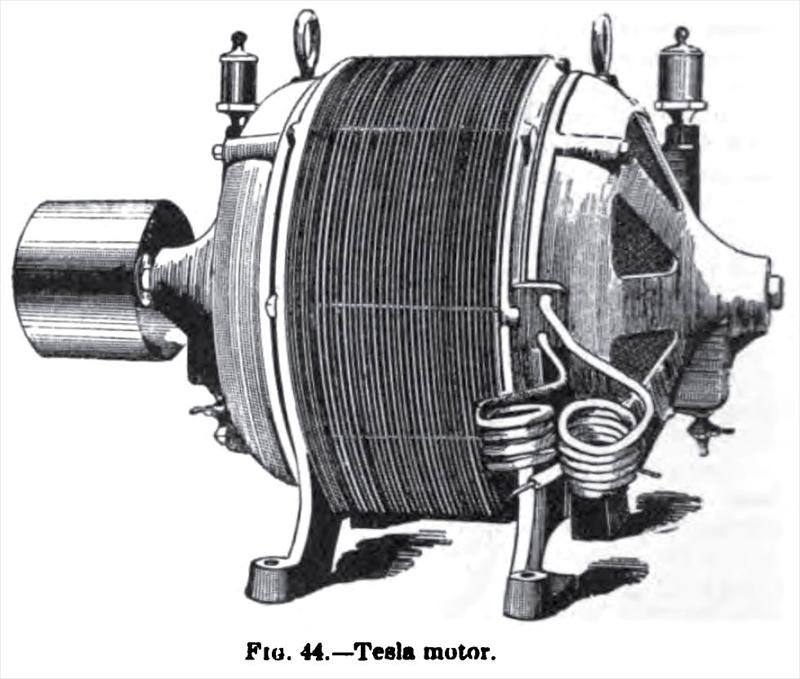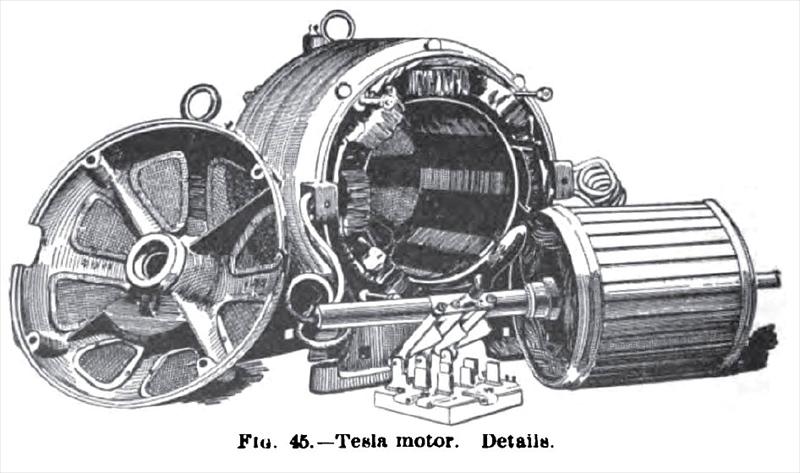|
Title: |
1895 Article-Westinghouse Electric & Mfg. Co., Tesla Electric Motor |
|
Source: |
Modern Mechanism 1895 pg 552 |
|
Insert Date: |
9/16/2011 8:55:07 PM |
The Tesla Alternating Motor.—Mr. Nikola Tesla was the first to baud a practical motor employing currents of different phase, or what are now termed "polyphasal currents. One of the types of the Tesla motor, as built by the Westinghouse Co.. is shown in perspective in Pig. 44, and with its parts exposed in Pig. 45. It consists of a series of magnets built up of laminated sheet-iron and wound with two sets of coils, the ends of which are connected to the two binding posts shown. These binding posts form the only connection with the regular lighting circuits, with the addition of a single return wire. By the aid of this return wire, two alternating currents are sent through the field of the motor at the same time, the pulsations of the two currents being equal in strength, but the one lagging a quarter phase behind the other in the two sets of field coils, respectively. The effect of this is that a rapidly rotating polarity is given to the field, corresponding in period to that of the currents producing it.
The armature core of the motor is of the Siemens drum type, and it is wound with a comparatively few turns of heavy wire, the ends of which are soldered together, forming a closed circuit having no connection with the energizing current. The alternating currents in the field induce secondary currents in the armature, and by the attraction between these and the revolving polarity of the field, armature rotation is produced, the rate of rotation corresponding very nearly with that of the field. "When no work is being done by the motor, the synchronism is exact, or nearly so and very little current passes either through the armature or field; but, as load is put on and the work increases, the armature tends to lag slightly, causing the passage of more current in proportion to the work done. The reaction between the armature and field is, therefore, similar to that between the primary and secondary of a converter when changes of lamp loads take place in the secondary circuit. The addition of the return wire for the motor circuit can be made easily, so as to adapt existing lighting circuits to motor work. The speed of the motor, as well as its direction of rotation, may be regulated by an ingenious adaptation of the converter principle, an adjustable "choking coil" arrangement being employed, which avoids the use of resistances and switches. The simplicity of the winding and general construction of the motor makes it unlikely to get out of repair. Thus the insulation of the armature is of no importance, since the current induced in it, though comparatively large in volume, has a potential of but a few volts, and often less than a volt, regardless of the voltage of the supplying circuits. |
|
 1895 Westinghouse Electric & Mfg. Co., Tesla Electric Motor
1895 Westinghouse Electric & Mfg. Co., Tesla Electric Motor
 1895 Westinghouse Electric & Mfg. Co., Tesla Electric Motor Details
1895 Westinghouse Electric & Mfg. Co., Tesla Electric Motor Details
|
|